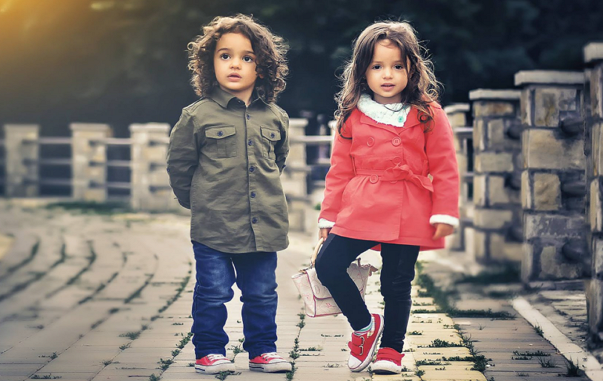
From bonnets and booties to onesies and tiny sneakers, baby fashion has come a long way over the years. Parents today have an incredible array of clothing options for their little ones, but how did we get here? In this journey through time, we’ll explore the fascinating evolution of baby fashion, from the past to the present.

A Look Back in Time
In the 19th century, baby fashion was a reflection of the times. Infants were swaddled tightly in long dresses and layers of fabric, both for warmth and to restrict movement. It wasn’t until the late 1800s that the concept of baby clothing began to shift, influenced by innovations in fabric production and changing social norms.
During the Victorian era, baby clothes were more about function than fashion. Babies were bundled in long, flowing gowns that covered them from head to toe. These gowns were primarily white, symbolizing purity. They were often adorned with lace and intricate embroidery, reflecting the Victorian fascination with detailed craftsmanship.
The Roaring Twenties
The 1920s brought a sense of freedom and rebellion, even in baby fashion. The iconic “flapper” style extended to infant clothing, with more relaxed silhouettes and playful prints. This decade saw the emergence of rompers and one-piece outfits, giving babies greater mobility.
In the 1920s, baby fashion took a cue from the adult fashion of the time. Girls wore drop-waist dresses with fringed hems, mimicking the iconic flapper style. Boys donned rompers, which were a departure from the more formal styles of previous decades. These changes allowed for more movement and comfort, reflecting the evolving attitudes towards child-rearing.
Post-War Baby Boom
The post-World War II era brought prosperity and a baby boom, leading to a focus on convenience and practicality in baby clothing. The 1950s featured pastel colours, tiny cardigans, and the iconic onesie, which remains a staple in baby wardrobes today.
During the 1950s, baby fashion saw a return to more traditional styles. Girls often wore dresses with full skirts, often accompanied by matching bonnets. Boys donned shortalls or rompers, and both genders were frequently dressed in pastel colours. The onesie, also known as a bodysuit, became a popular choice for infants due to its practicality and ease of diaper changes.
The Swinging Sixties
The ’60s were a time of rebellion and experimentation, and this spirit extended to baby fashion. Mini skirts, bright colours, and bold patterns found their way into baby clothing, reflecting the changing cultural landscape.
In the 1960s, baby fashion took on a more playful and vibrant character. The influence of pop culture, including the rise of iconic figures like The Beatles and Twiggy, was evident in baby clothing. Baby girls might be seen in mini dresses with bold, psychedelic prints, while baby boys rocked mod-inspired ensembles. These trends reflected the broader cultural shift towards individualism and self-expression.
The Gender-Neutral Movement
In recent years, there has been a significant shift towards gender-neutral baby fashion. Parents are moving away from traditional pink and blue colour schemes, opting for more inclusive designs and colours. This change reflects a broader cultural shift towards breaking down gender stereotypes.
Contemporary baby fashion is increasingly defined by its inclusivity. Parents are embracing a more diverse and open approach to clothing choices for their children. Gender-neutral clothing in soft, earthy tones and unisex patterns has gained popularity. This movement encourages self-expression and allows children to explore their individual styles without being limited by traditional gender norms.
The Rise of Organic and Sustainable Materials
Today’s parents are increasingly conscious of environmental issues. They’re choosing baby clothing made from organic and sustainable materials, such as organic cotton and bamboo. These fabrics are not only gentle on the planet but also on a baby’s sensitive skin.
Sustainability has become a central concern in modern baby fashion. Organic cotton, bamboo, and hemp are replacing conventional cotton as preferred materials. These fabrics are grown without harmful pesticides, making them safer for the environment and less likely to cause skin irritations in babies.
High Fashion for Tiny Tots
Celebrity culture and social media have fueled the demand for high-end baby fashion. Luxury brands now offer mini versions of their iconic pieces, allowing even the tiniest trendsetters to make a fashion statement.
The rise of “baby influencers” on social media has contributed to the demand for designer baby clothing. Parents are willing to invest in high-quality, stylish pieces for their little ones to showcase on platforms like Instagram. Luxury brands have responded by creating exclusive lines for babies, featuring miniature versions of their signature
Final Thoughts
In conclusion, the evolution of baby fashion is a remarkable journey through time, reflecting not only changes in clothing styles but also shifts in societal norms and values. From the tightly swaddled Victorian infants to the vibrant and gender-neutral styles of today, baby fashion has come a long way.
Parents now have the freedom to choose from a wide array of materials, designs, and ethical considerations when it comes to dressing their little ones. Sustainability and inclusivity have become central themes, as parents seek clothing that is not only stylish but also gentle on the environment and suitable for all genders.
You might also be interested in:
- Clothing For Your Baby
- Baby Clothes Shopping: Tips for New Parents
- Baby Items Every New Mother Must Buy
- How to Care for Your Baby’s Clothing
